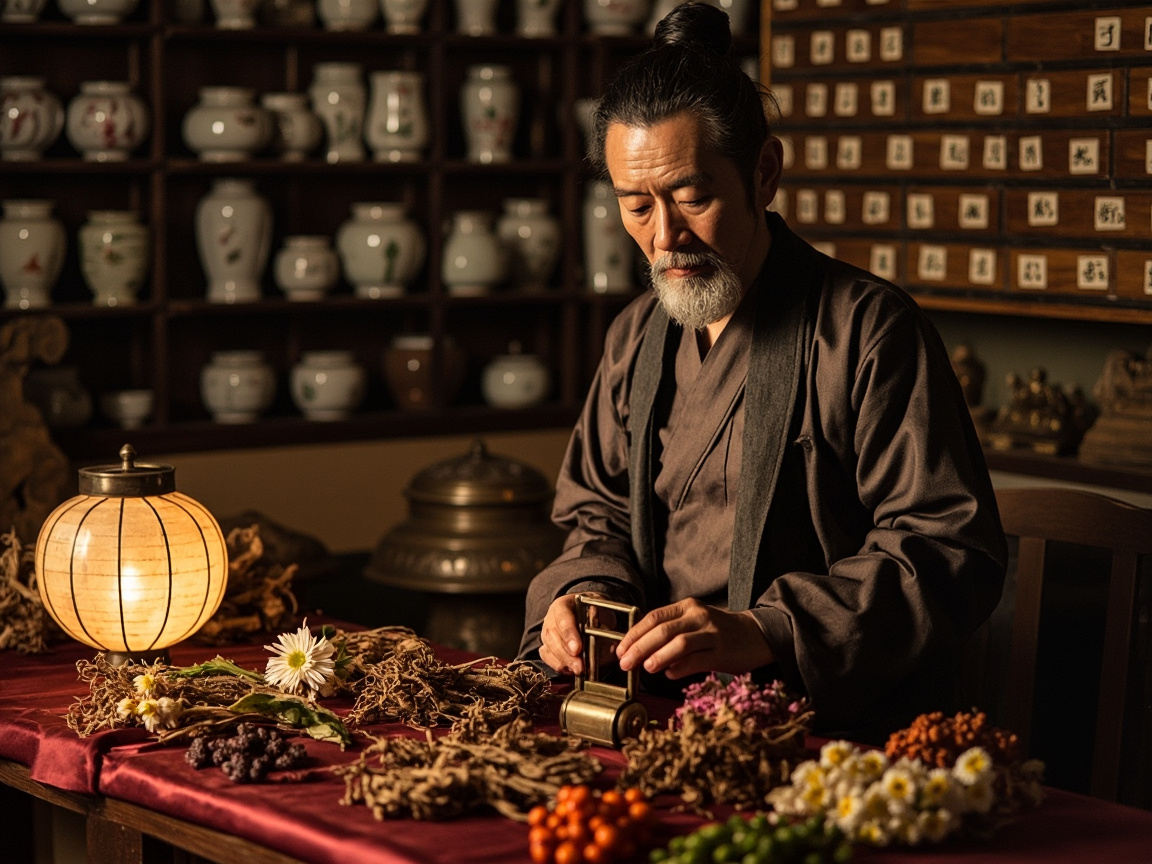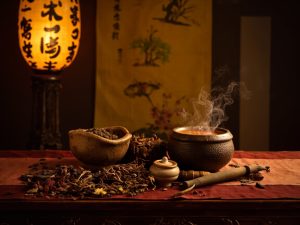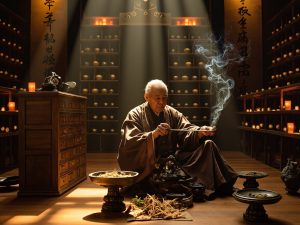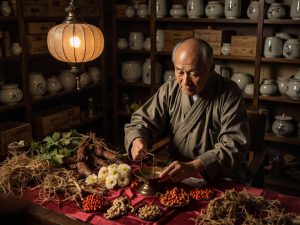Table of Contents
ToggleMa Huang Sheng Ma Tang – Nan Kaiyang
Author: Nan Kaiyang Editor: Gu Yuxi Translator: Gu Yuxi
Article:
Differentiation and Treatment of Jueyin Disease, Chapter Twelve
357. For cold damage of six or seven days, after severe purging , with the cun pulse deep and slow, cold extremities , absence of pulse in the lower body , discomfort in the throat and pharynx , spitting pus and blood and unrelenting diarrhea ; this is difficult to treat. Ma Huang Sheng Ma Tang is indicated.
Interpretations by Famous Scholars:
Ma Huang Sheng Ma Tang is arguably the most controversial formula in the entire Shang Han Lun. For instance, Ke Yunbai stated in Shang Han Lai Su Ji: “The old edition contains Ma Huang Sheng Ma Tang. Its numerous ingredients and light dosages, strong sweating and dispersing effects while fearing warming and tonifying, are techniques of later crude practitioners and certainly not Master Zhongjing’s formula.”
Tanba Mototsune mentioned in his work Shang Han Lun Ji Yi: “For this clause, the symptoms and formula do not match. Commentators all consider it a case of Yin-Yang disarray, providing explanations to reconcile them. However, Mr. Ke resolutely declared it not to be Master Zhongjing’s true formula, which can be considered a profound insight for all ages.”
Among modern scholars who study Shang Han Lun, Ren Yingqiu also explicitly agreed with Ke’s statement. Although the above three scholars expressed dissent regarding whether Ma Huang Sheng Ma Tang is Zhongjing’s formula, most scholars believe this formula is rigorous and well-proportioned, with matching symptoms and formula. Wang Xugao said: “Such a mixture of symptoms and ingredients is rarely seen in ancient formulas. Observing this, one can see how ancient practitioners used formulas very individually.” This shows that Zhongjing’s use of formulas also had its special characteristics. In Shang Han Guan Zhu Ji, You Zaijing stated: “Ma Huang Sheng Ma Tang combines supplementing and purging, cold and hot properties into a single agent, allowing them to assist each other without conflict, so that each performs its function and collectively presents its efficacy.” He believed this concisely summarized the symptoms of Jueyin disease that Ma Huang Sheng Ma Tang addresses.
In Yi Zong Jin Jian (Golden Mirror of Medicine), compiled by the Qing Dynasty physician Wu Qian, it is recorded: “Zhongjing thus prescribed this decoction, precisely to show people that Yin-Yang disarray is difficult to treat, and one must seek treatment methods for both the exterior and interior, and upper and lower. Indeed, upper heat and lower cold are difficult to treat. If there is internal cold without sweating, resolving the exterior is still appropriate. Therefore, Ma Huang Sheng Ma Tang is used to resolve the exterior and harmonize the interior, clear the upper and warm the lower, treating according to the symptoms.” By this point, the explanation of the formula and its indications is quite appropriate.
There are eight instances in the Shang Han Lun where “difficult to treat” is mentioned, and Ma Huang Sheng Ma Tang is the only formula given by Zhang Zhongjing for a “difficult to treat” condition. Precisely because the condition is complex and a single formula cannot provide a solution, some people argue that this is not Zhongjing’s formula because other “difficult to treat” clauses do not have a corresponding formula. It is precisely because this formula is the most complex in the Shang Han Lun that Ke Yunbai commented: “Using fourteen ingredients is like casting a wide net to catch a rabbit, similar to Fang Feng Tong Sheng San and other formulas, which are symbols of crude practitioners.”
The argument that the establishment of Ma Huang Sheng Ma Tang lacks clear pathogenesis and specific targets for its ingredients, akin to “shooting birds with random shots,” has been agreed upon by many later scholars. Although the ingredients are complex, most physicians believe that complex evils should be resolved with complex medications. As Wu Jutong stated in Wen Bing Tiao Bian (Systematic Differentiation of Warm Diseases): “Because the disease qi is complicated, one has no choice but to treat it by both conforming and opposing.” Xu Lingtai, precisely because of the complexity of the symptoms and the multitude of ingredients—a rarity in ancient formulas—believed that observing this could enlighten one about the ancient method of using medications. Mr. Cheng Menxue, through years of dedicated study and careful contemplation, with unique insight, broke new ground and refuted many doubts. He believed that this syndrome was “different from Yin exuberance blocking Yang” and belonged to “upper heat and lower cold,” due to “exterior evil sinking into ying (nutritive Qi) and cold binding heat depression.” He also refuted Ke’s argument by citing Li Donghuan’s Ma Huang Ren Shen Shao Yao Tang for treating hemoptysis, stating: “Mr. Ke did not consider this and thus made a definitive judgment, which is inappropriate.”
Detailed Analysis of This Formula and Its Indications:
This clause is not simply a problem caused by severe purging; therefore, Master Zhongjing said it was “difficult to treat.” Observing Zhongjing’s book, severe purging can lead to fluid deficiency (or difficulty with urination, refer to clauses 51 and 241), or in cases where there was existing heat but not yet substantial accumulation, purging not only fails to remove heat but can also lead to heat sinking inwards and weakening the Yang Qi (refer to clauses 78 and 80). Therefore, this syndrome should be one where evil heat, after purging, has sunken into the Yin aspect. It can be analyzed from the Yang channels, specifically Shang Han Lun clause 146 (Chai Hu Gui Zhi Tang). If severe purging is performed at this point, it injures fluids and impairs Spleen Yang, potentially leading to symptoms of upper heat and lower cold, with mixed deficiency and excess. Jueyin is where Yin reaches its extreme and Yang begins to emerge. When Shaoyang fire attempts to rise, the ministerial fire is suppressed, resulting in a Jueyin cold damage syndrome. Coupled with the inherent deficiency of Yin essence and decline of Yang Qi in Jueyin disease, severe purging leads to the cold evil remaining bound, and depressed heat sinking into the Yin, resulting in this syndrome. Thus, viewing it as Jueyin cold damage further complicated by severe purging is more appropriate.
Application of the Formula and Its Indications:
1、
Zhang Zhongjing said, “If Yin and Yang Qi do not connect smoothly, it becomes jue” . This shows that the cold extremities and absence of pulse in the lower body in this syndrome are similar to Si Ni Tang for Yin exuberance and Yang decline. However, this syndrome is in fact due to Yang Qi sinking inwards after severe purging, becoming depressed and unable to reach the surface.
2、Discomfort in the throat and pharynx, spitting pus and blood.
(1) This is caused by evil invading Jueyin and fumigating the Upper Jiao. Cao Yingfu believed: “Due to Yin deficiency in the Liver, Gallbladder fire rebels upwards, bile at the bottom of the stomach becomes dry, rushing up to the lungs, leading to discomfort in the throat and spitting pus and blood.” The “discomfort in the throat and pharynx” here is not swollen and painful throat, nor is it difficulty swallowing (Zhongjing referred to difficulty swallowing as “ye” ).
(2) Regarding spitting pus and blood: This is not lung heat spitting pus due to lung fistula after severe purging. “The pharynx connects to the stomach and the throat connects to the lungs. Zhongjing simply refers to them collectively; there is no distinction between lung and stomach. It merely points to heat evil in the upper body.” It can be said that this syndrome is due to the struggle between Yang Qi and cold-heat, leading to depression and transformation into heat. If the evil obstructs the throat and pharynx, it causes throat impediment. If the depressed heat is severe and invades the lungs and injures the stomach, coupled with fluid injury after purging, it is reasonable that lung heat corrupts into pus or stomach heat forms pus. Therefore, this phrase actually needs no dispute.
3.Three interpretations of “spitting pus and blood”:
1.Lung fistula spitting pus and blood.
2.Stomach heat spitting pus and blood.
3.Development of throat impediment.
I believe it is more likely an exterior manifestation resulting from injury to Spleen Yang after purging, where righteous Qi is deficient, evil sinks, and Yang is depressed. The Yang heat is depressed in the upper body and cannot reach the exterior, thus manifesting as a “deep and slow cun pulse.” Spleen deficiency and intestinal cold lead to “unrelenting diarrhea.” Heat binding in the upper body easily injures body fluids, and unrelenting diarrhea further severely injures body fluids, thus leading to Yin deficiency and raging heat, manifesting as “discomfort in the throat and pharynx, spitting pus and blood.” Spleen Qi sinking and Yang Qi being depressed internally, unable to ascend to the exterior, lead to “absence of pulse in the lower body, cold extremities.” This belongs to a syndrome of upper heat and lower cold, with mixed deficiency and excess. The pathogenesis is complex, hence it is “difficult to treat.”
Disclaimer:
The experiences and insights shared above represent the author’s personal usage and understanding, and are provided for reference only as part of academic exchange. Please do not blindly replicate or apply them; any consequences arising from such actions are solely your responsibility. As individual constitutions vary, medication should be tailored accordingly. It is advisable to use such treatments under the guidance of a qualified physician. If you have additional experiences to share, comments and submissions are welcome.
If you appreciate my article, please give it a like.
If you are a generous and affluent individual, please consider making a donation!
Your recognition is my greatest motivation to continue writing—thank you very much!
USD Donation Button —
A RMB donation button is available below.
 微信赞赏
微信赞赏 支付宝赞赏
支付宝赞赏




